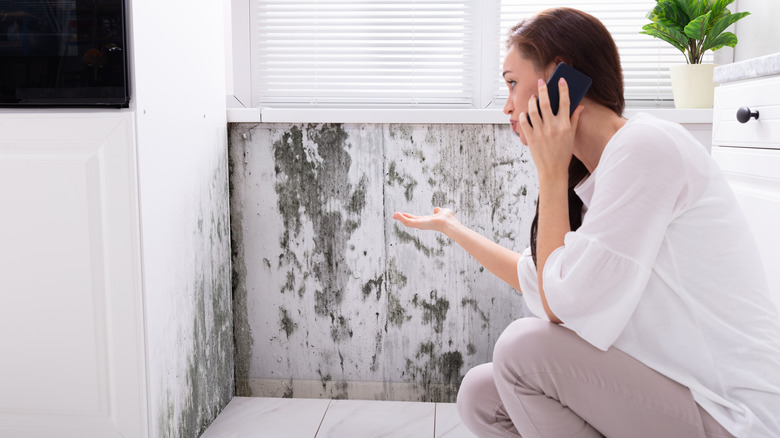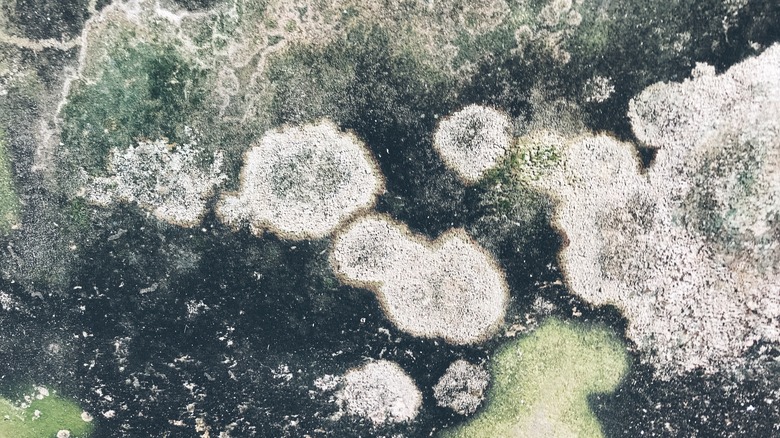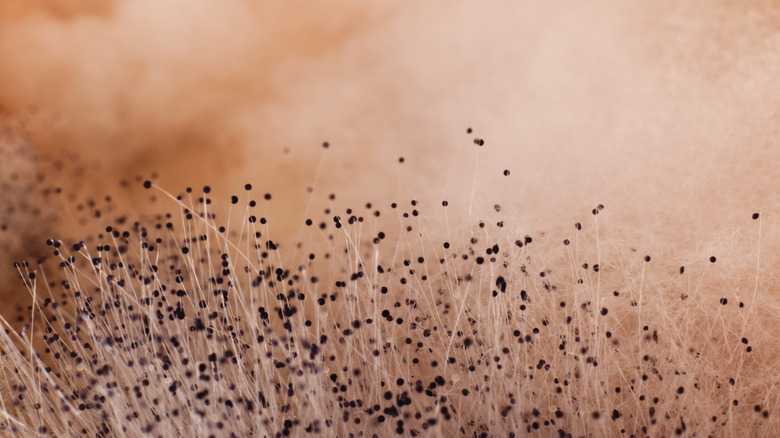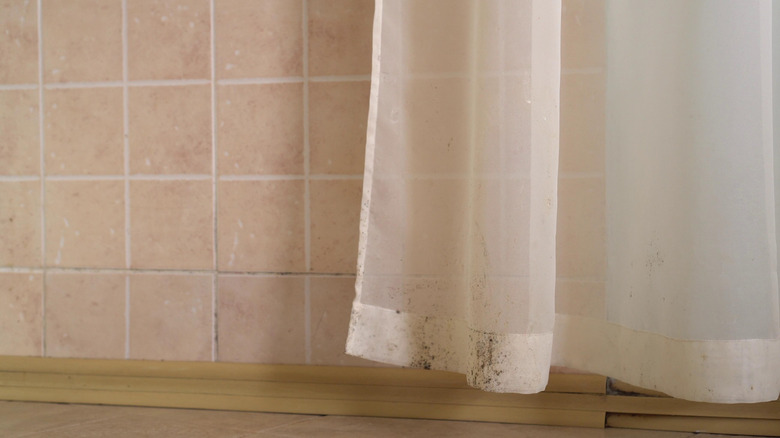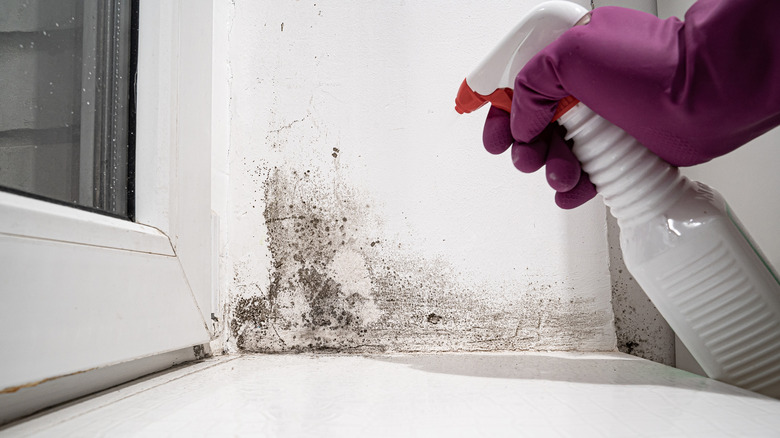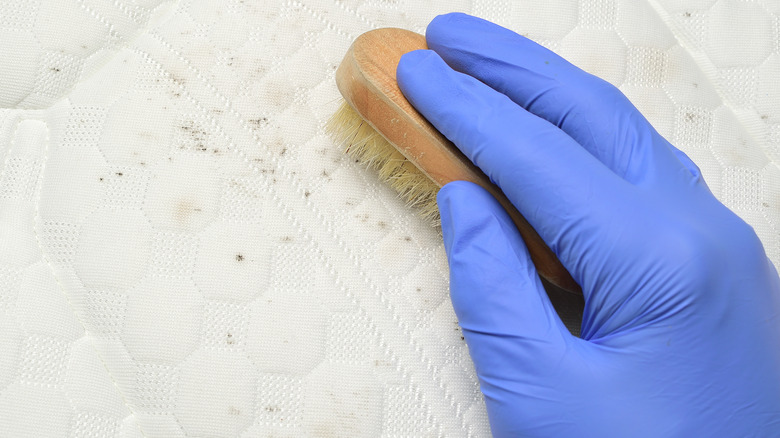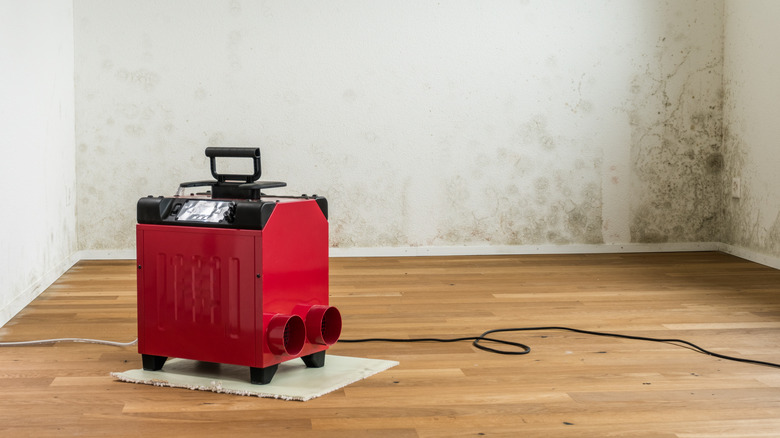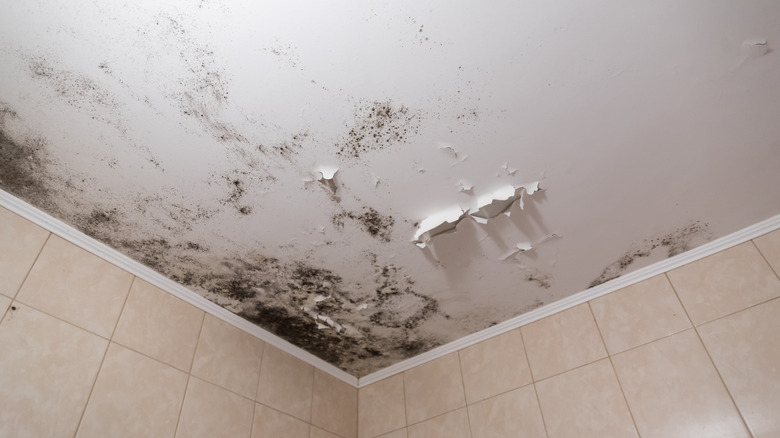The Difference Between Mildew And Mold Explained
Mold and mildew can be concerning when you see them in your home. These growths are types of fungi. Both have a musty odor, and that smell might be your first sign that it is lurking somewhere. If left alone, mildew and mold will stain the surface they are on, and in some instances, eat into whatever it's growing on and cause it to rot, according to the University of Missouri Extension.
Mildew and mold develop and thrive in areas that stay moist. Leaky pipes, floods, and humidity provide a starting place for mildew and mold to grow, and it will continue to grow until it is stopped (via TruSens). Spores can live just about anywhere in the right conditions, including ceiling tiles, wallpaper, insulation, and drywall. The Centers for Disease Control and Prevention (CDC) point out that the most common types of mold found in homes are Cladosporium, Penicillium, and Aspergillus.
Mildew looks different from mold
Mildew and mold look similar, but a few differences help you determine what you are dealing with. Mildew has a different growth pattern than mold. It expands outward, and it stays flat, according to the U.S. Environmental Protection Agency (EPA). It is generally a white or grayish color that eventually turns brown or black. When mildew is in the early stages of growth, it will appear as small white dots. It also has a more powdery appearance than mold, per The Spruce.
On the other hand, Mold is usually black or green, and it will look either fuzzy or slimy (via HGTV). Mold can be any color, depending on what type it is. Color, however, does not indicate how dangerous a particular mold is. If allowed to spread, mold will grow upward, resulting in a plump shape (via TruSens).
Mildew and mold form in the same way
Mildew and mold both grow from spores, and spores need what all living things need to survive: Food, water, and oxygen. Mildew and mold spores are microscopic, and they travel through the air, per the EPA. Spores can land anywhere, but they will not start growing unless there is some moisture. Just about anything can serve as a food source for mildew, including cotton, silk, wool, paper, and wood.
Something as harmless as a little bit of dirt on clothing is enough to give mildew a chance to grow if there is enough moisture in the air and the temperature is right, according to the University of Missouri Extension. Spores can start growing on a surface in as little as 24 hours in the right conditions. Mildew and mold can grow quickly in dark areas with little ventilation, per The Spruce.
Where mildew and mold grow
While mildew and mold need moisture to grow, they don't need much. Areas that offer almost perfect conditions for mildew and mold are basements, bathrooms, kitchen walls, and windowsills, as per the University of Missouri Extension. But they are not limited to those places. You might also see it on paper, leather, and even plant leaves. Molds also prefer areas with low lighting, making closets, crawl spaces, and shower curtains ideal.
It can also form in areas where water drips, such as a ventilation pipe or an exhaust fan (via The Spruce). It is worth noting that different spores prefer different temperatures, which means you can find them in warm or cool environments, as indicated by the EPA.
Removing mildew and mold on walls
For heavy mildew on walls, full-strength vinegar works well. Misting vinegar on the backs of rugs also works as a deterrent, according to Healthline. Since vinegar is acidic, it can damage some surfaces. For this reason, you should not use it on stone countertops, wooden floors, aluminum, copper, or any kind of porous surface. Don't mix it with hydrogen peroxide because that will create toxic fumes.
Vinegar does not work on all types of mold. If you don't get results from vinegar, you can try misting hydrogen peroxide on moldy areas. After letting it sit for 10 minutes, gently rub it away. A baking soda solution might also work. Simply mix the baking soda with water to make a paste, and apply directly to the mold and wait for 10 minutes before wiping it away. For areas larger than 10 square feet, you might want to call a professional. Furthermore, if mold or mildew has made its way to the ducts in your ventilation system, you might need additional help.
Removing mildew from other surfaces
If you spot mildew on clothing, take it outside and brush away the spores to prevent scattering the spores inside. Allow the fabric to get sun and fresh air. Wash stained clothing as you usually would, and allow it to air dry if possible. You can also try scrubbing fabric with a mixture of lemon juice and salt before placing it in the sun. Other over-the-counter products might also work, according to the University of Missouri Extension.
Place furniture, mattresses, rugs, and other large items outside and allow them to dry as much as possible. Brush away any mold and follow up with a vacuum cleaner. Remove the vacuum bag and empty it carefully outside. Do what you can to dry the affected area. Use a sponge and soapy water if necessary to remove tough stains left behind using as little water as possible. A mixture of one part water with one part alcohol can also work – especially on leather. Wood surfaces can be cleaned with washing soda, disinfectants, or trisodium phosphate. You might need to remove any paint or stain to remove all the mold.
Preventing the growth of mildew and mold
One of the best approaches to stopping mildew and mold from growing is to keep areas where it is most likely to thrive clean. Since moisture is necessary for each to grow, removing any dampness might stifle growth. Heating the air in an area for a short time might help dry out mold on walls. You can also open doors and windows, allowing fresh air to circulate, according to the University of Missouri Extension.
In enclosed areas, such as a closet, use a fan to circulate the air. Dehumidifiers work to eliminate moisture in the air. Air conditioners can also remove humidity. If you use a dehumidifier or an air conditioner, close windows and doors. You can also purchase chemicals that work to absorb moisture.
A word about black mold
Some molds are considered more toxic than others, with black mold being at the top of the list. When people talk about toxic black mold, they generally talk about Stachybotrys chartarum because it releases mycotoxins into the air, as per Medical News Today. Some people are more sensitive to mycotoxins and can experience severe reactions.
People can be sensitive to different kinds of mold — not just black mold. In some cases, they can develop mold poisoning, called mycotoxicosis. Mycotoxicosis symptoms include watery eyes, a dry cough, and a stuffy nose. In addition, people who have asthma or lung problems may experience worse symptoms after coming into contact with it. While other conditions such as headaches, memory loss, nosebleeds, and moodiness are blamed on black mold exposure, there is no scientific evidence to support this theory, according to the journal Clinical Reviews in Allergy & Immunology.
